Kingdoms are at war, with each hoping to rule the land. Lay siege to your opponents, or attack the invaders of your own castle. The ultimate goal: find and eliminate the other kings, and victory is yours.
At a glance: Siege is a game by Jeremie Kletzkine for 2 to 6 players, ages 14 and up, and takes about 10 minutes to play. It retails for $24.99, though you can find it for less. Although the game is rated for 14 and up, I’ve played with my 10-year-old daughter as well, and she was able to learn the rules—the deduction and strategy is a little trickier for her, however. It’s a little bit like Love Letter meets Stratego.
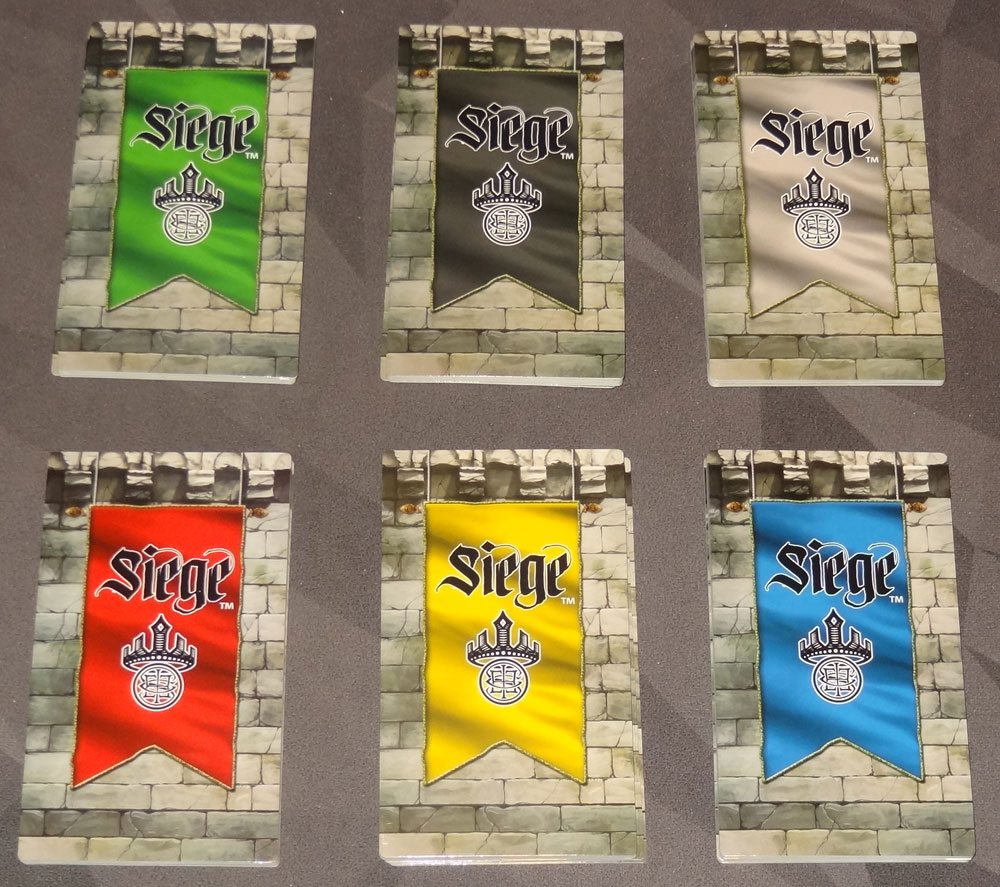
Components
Siege contains 42 cards: 6 sets of 7 cards each in different player colors. The cards are tarot-sized and are stiff with a glossy plastic coating, so they feel pretty durable. Each card has a value from 0 to 6, a name, and the character portrait, and all but the Gong Farmer have special abilities printed at the bottom. The numbers and text are printed in large text and are easy to read. The artwork is nice—Kings, Courtiers, Assassins, and so on.

The box is half full (or half empty?) when you open it—the wells of the plastic insert are clearly labeled “Siege” and “Siege Expansion” so it’s clear that AEG has plans to fill this box later.
How to Play
You can download a copy of the rulebook here.
The goal of the game is to be the last player remaining by eliminating all the other Kings. If your King is ever eliminated in any way, you are immediately out of the game, and all of your remaining cards are removed from play.
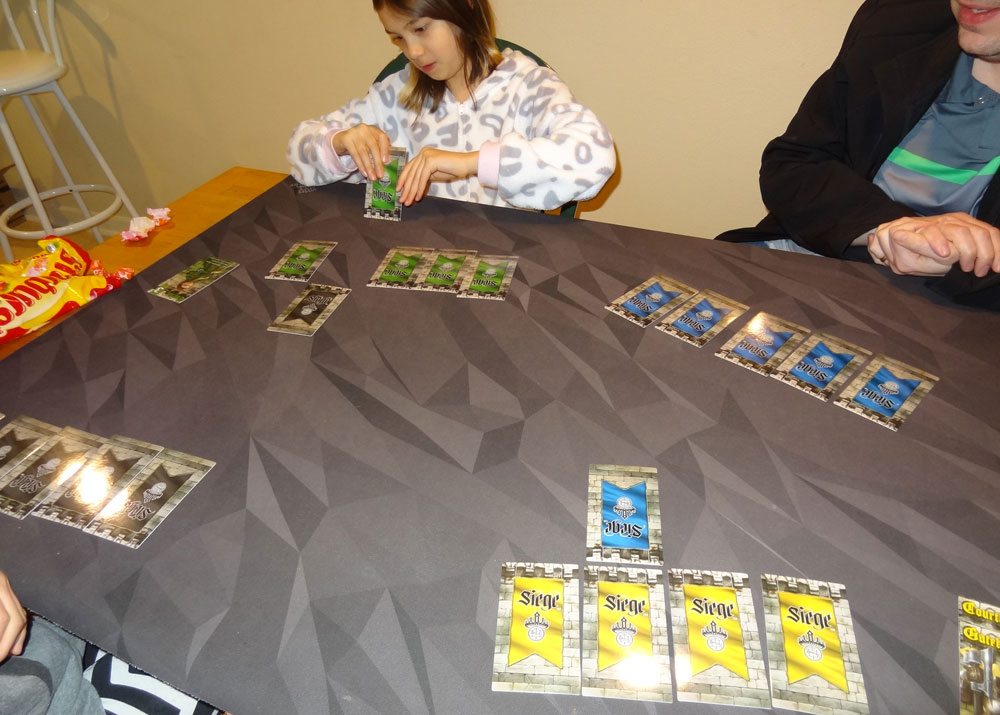
To set up, each player takes a set of cards and lines them up face-down in a row, forming their castle. (Note: for new players, remove the 0-value Gong Farmers from the game—they can be added later when players have a better feel for the game.) You can decide the order of your cards and you are always allowed to look at any of your face-down cards at any time throughout the game, but you may not rearrange cards once placed.
Each turn, you get one action from the following:
- Go into siege
- Launch an attack
- Sacrifice
- Fall back

Go into siege: Choose one of your cards from your castle that is not under siege, and place it face-down in front of another player’s card in their castle. Your card is “in siege,” and their card is “under siege.”
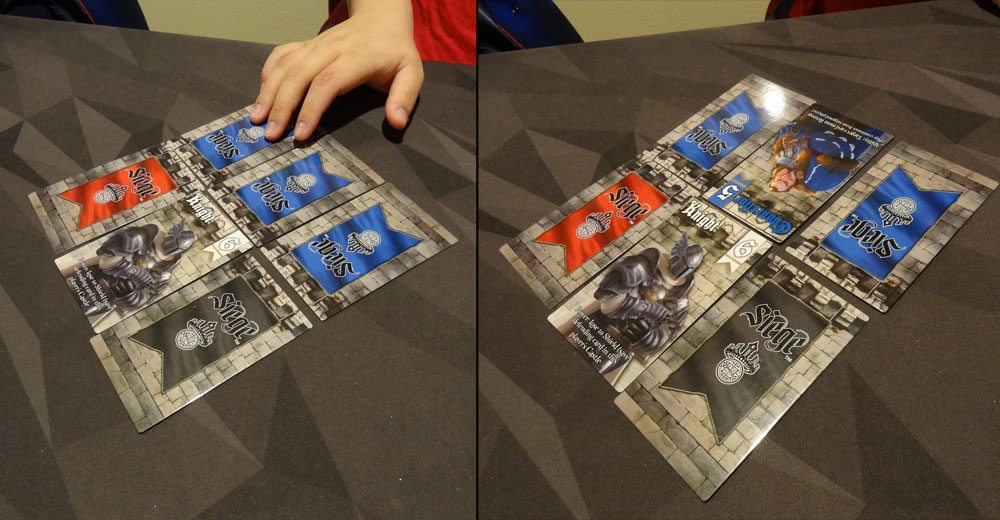
Launch an attack: Choose any of your cards that is either in siege or under siege to attack. The opposing card is now the defender (even if they were in siege against your castle). Reveal your card. The other player secretly looks at their own card, and checks to see if the attacker wins or loses—in general, the higher number wins, and defender wins ties. However, there are some card abilities that affect the outcome. If the attacker wins, the defender reveals their card and then discards it; if the defender wins, the defender’s card is not revealed and stays in place. Win or lose, the attacker’s card is discarded.
Sacrifice a card: You may sacrifice a card from your castle that is not under siege by revealing it and discarding it. If it has an “Ability” on it, then that ability is activated. If it has no ability, it is simply sacrificed with no effect. In the base game, only two cards have abilities, the Courtier and the Chancellor. The Courtier lets you choose a player to go next—they must sacrifice a card as their turn if possible, or take a different action otherwise. The Chancellor lets you choose a player to go next, and you select one of their “in siege” cards to return to their castle. (The card that’s returned can go anywhere in their castle, but not under siege.)
Fall back: If you have a card that is in siege but has no corresponding card under siege, you must fall back on your turn by returning the card to your castle, placing it into any position but not under siege.
Once you’ve taken your action, play passes clockwise.
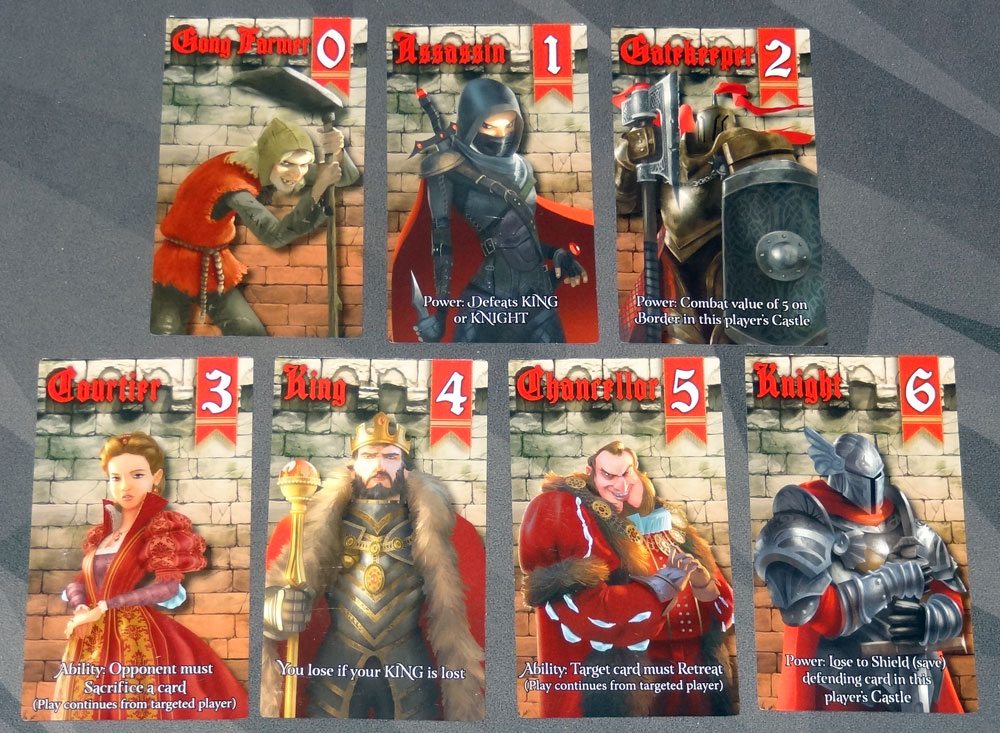
Here are the various characters and their abilities:
- 0 – Gong Farmer: no special ability
- 1 – Assassin: defeats King and Knight
- 2 – Gatekeeper: has a value of 5 if it’s on either end of your own castle
- 3 – Courtier: sacrifice to force another player to sacrifice
- 4 – King: you lose if your King is lost
- 5 – Chancellor: sacrifice to force a card to retreat
- 6 – Knight: may be discarded from your own castle (if not under siege) to prevent another card in your castle from losing to an attack
The game ends as soon as all but one player has been eliminated.
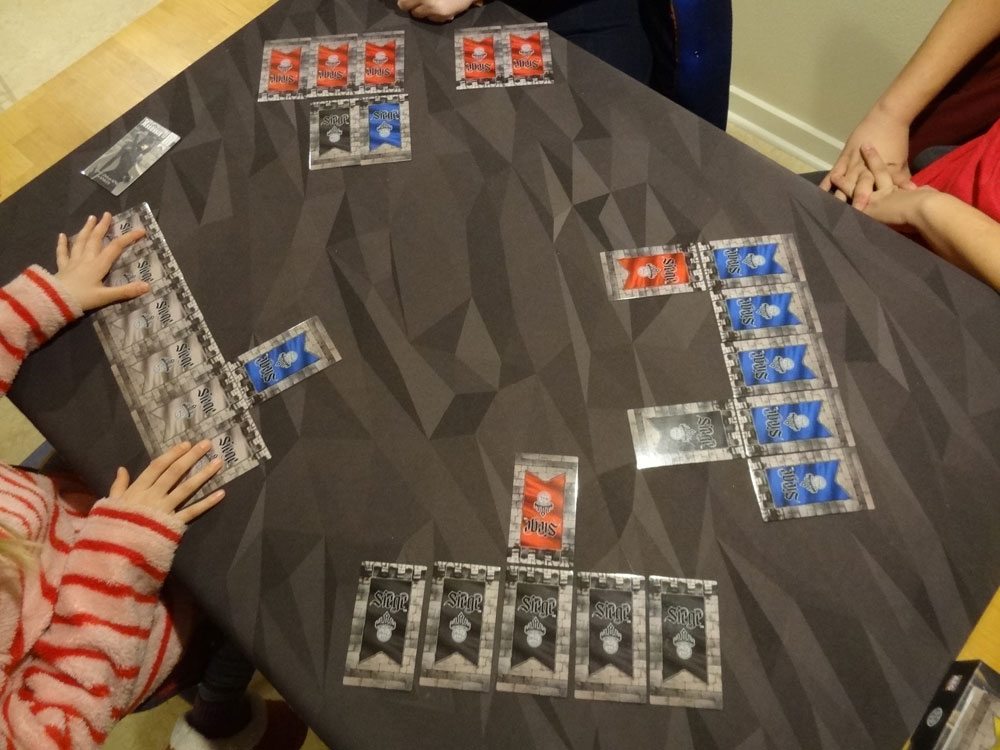
The Verdict
As I said above, Siege reminds me a little of Love Letter and a little of Stratego. Like Stratego, you have units of varying strength that are hidden from the other players—they’re only revealed when making an attack, and you have to have the right strength (or special power) to win the attack. Like Love Letter, it’s a small set of cards—only 6 or 7 per player—and there are some interesting powers that interact with each other. You have to use your actions wisely, and the game goes very quickly.
The first time I played Siege, not all the players really got it—for some, they felt it was a total stab in the dark when they put a card in siege or decided to attack. But after a couple plays, I’ve realized that there’s more to the game than just dumb luck. For instance, you know that the Gatekeeper is most effective when it’s on the end of your own castle—so will other players put their Gatekeepers on the ends? It’s less useful if you send it out to attack, because then it only has a value 2. The Knight is the strongest card in the game with value 6, which makes it useful in siege—but it can also be used to protect another card in your castle.
The trickiest part, though, is that the attacker always gets discarded, whether you win or lose. So you never want to attack unless you’re pretty sure you can win, because then at least you cost your opponent a card for your lost card. Instead, you want to put cards in siege, and then hope that your opponents will attack you, costing them a card no matter what. Because there are so few cards, if nobody launches attacks, eventually all the cards will be in siege and under siege and an attack is inevitable. It seems that a key to strategy is forcing other players to make unwise attacks.
The Courtier and Chancellor are both powerful abilities, but they cost you the card. It’s worth it, though, if you can force a player to discard their King because it’s the only card they have left in their castle that isn’t under siege. The Knight’s shield power can save you from losing, but using it may lead others to the location of your King.
Speaking of your King, at first you’ll think you never want to send your King into siege, because if you attack with it, you lose. However, it’s important to note that going into siege isn’t the same thing as attacking. You can put your King in siege, and then just wait for it. After all, it has a 4 value, which is not too shabby, and if you pin down another player’s King, as soon as they attack, they’ll be eliminated.
Since you don’t reveal your card when you win as a defender, there’s a bit of deduction going on as players try to figure out what might have beat their attacker and who they should send next. Clever players will be able to figure out identities and use that to their advantage. My kids have really enjoyed playing this one, particularly my 10-year-old.
No matter what, though, the games don’t last very long—again, because there are only so many cards per player. Eventually, all the rulers will be lost to assassins, or forced to attack, or get sacrificed, leaving one King to reign … at least until new Kings arrive to challenge him.
If you like quick deduction games, Siege is a clever little game that will pair nicely with Love Letter. I’m looking forward to seeing what the expansion brings, too, though there hasn’t been a release date announced yet.
Disclosure: I received a review copy of this game.





